2021 Research Review


Harnessing remote technology to get a bigger, better view of the world around us
Research at the forefront of the burgeoning in-space manufacturing field
2024 Research Review

Data Points
Recent news from across the UNH research enterprise- Honors
Accolades to our faculty, graduate students and postdoctoral researchers - Findings: Dogging a Mysterious Illness
UNH researchers find a major clue to canine respiratory syndrome 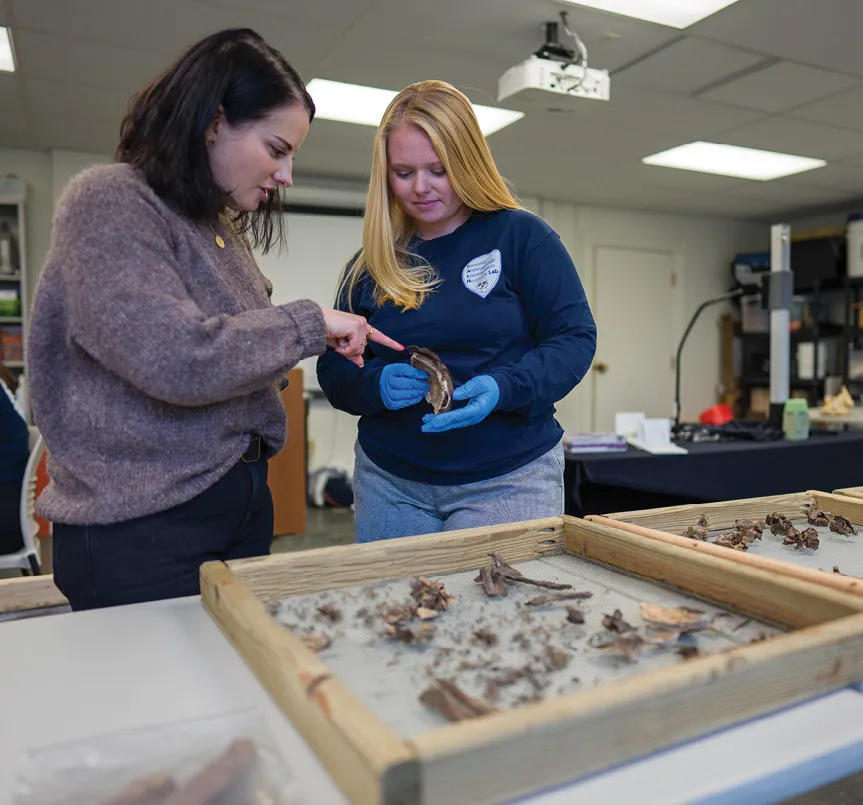
Discovering Ina Jane Doe
Forensic anthropologist Amy Michael discusses a new book highlighting her cold case research- Research Snapshot: Squash and Pumpkin Breeding
Andrew Ricketts ’26 found his spark with UNH’s legendary cucurbit breeding program - Remote Research
How UNH researchers harness remote technology from the sky to the sea to get a bigger, better view of the world around us - Advancing Sustainable Business
Businesses can be profitable and have positive environmental and social impact, researchers show 
Engaging Industry, Exceeding Expectations
N.H. printed circuit board manufacturer GreenSource Fabrication has forged rich partnerships with UNH- Ecological Eavesdropping
Tuning in to the rapidly growing field of environmental acoustics research 
Findings: Extension to the Rescue
On the heels of a challenging winter, outreach helped N.H. fruit producers mitigate crop losses
Made in Space
Research at the forefront of the burgeoning in-space manufacturing field- His Moment in the Sun
Heliophysicist Ian Cohen ’15G carries on UNH’s space physics legacy at Johns Hopkins Applied Physics Laboratory 
By the Numbers
FY23 research, economic engagement and outreach at a glance-
On the Cover

UNH’s autonomous surface vessel DriX maps the seafloor remotely. Exail, the French company that manufactures DriX, recently opened the Maritime Autonomy Innovation Hub at UNH. Photo by Nova West/Ocean Exploration Trust
Curiosity. Discovery. Innovation.
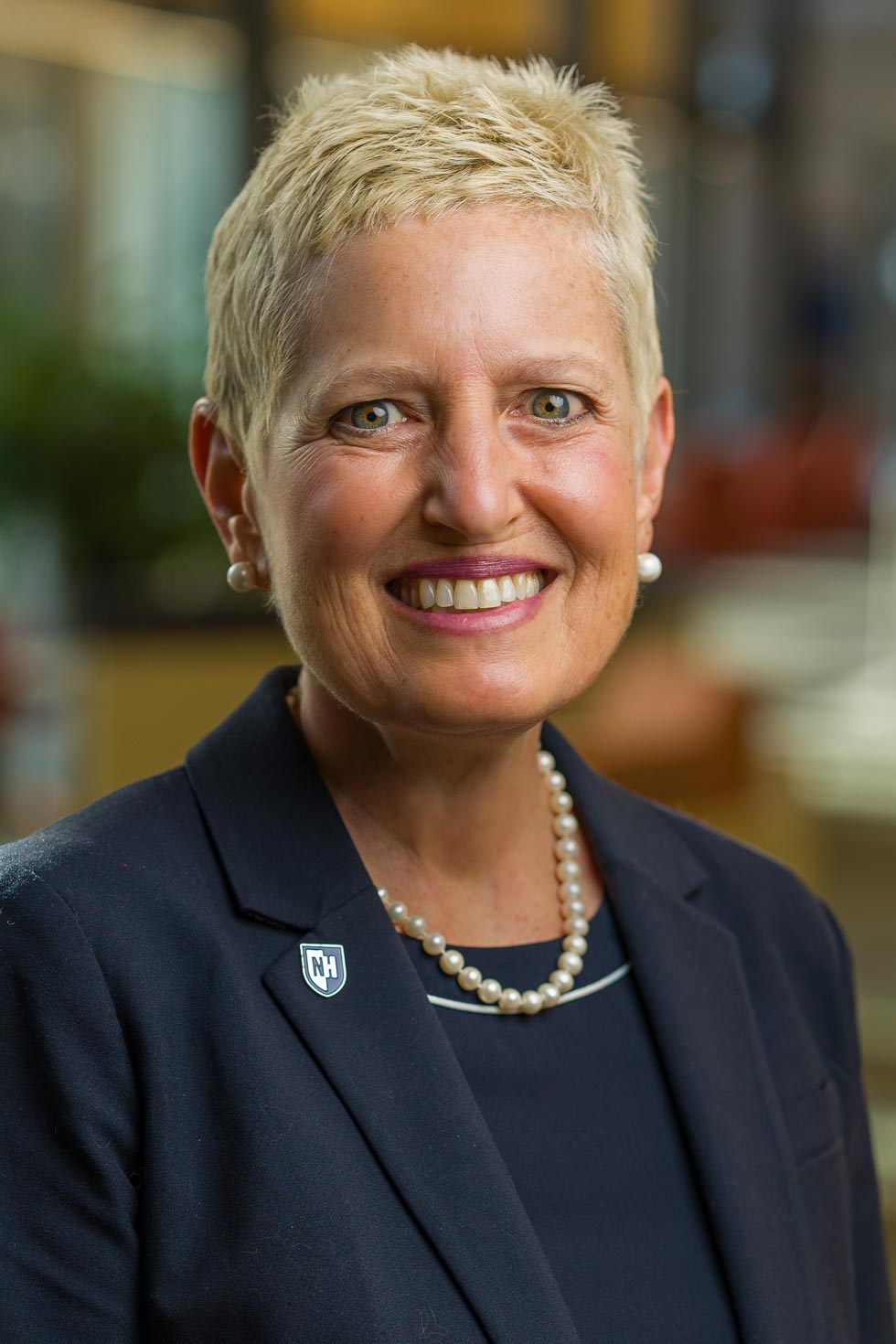
Welcome to the 2024 edition of Spark, which chronicles our researchers’ quest to ask — and answer — these questions, and many more.
Their impulse for inquiry is not mere curiosity (although we hope it piques yours!). Research at UNH seeks solutions to familiar problems, like mapping our seafloor for better navigation or using DNA to bring closure to cold cases, and to those we’re just beginning to imagine. How can we recycle space debris to create a lunar landing station? How do bats keep from flying into each other?
Creating new knowledge that improves lives is at the core of our mission as the state’s public flagship research university. UNH also takes seriously its mandate to advance economic opportunities in New Hampshire. In these pages, you’ll learn about several industry partners who have expanded their footprints on our Durham campus to engage more deeply with our world-class facilities, researchers, students and the state we call home.
I hope you enjoy these stories of curiosity, discovery and innovation. Together, they tell a compelling tale of UNH’s ascending research success and its powerful impact in New Hampshire and beyond.
Senior Vice Provost
Research, Economic Engagement & Outreach
- SPARK
-
2024 Research Review
- unh.edu/research
-
President
James W. Dean Jr.
-
Provost and Vice President for Academic Affairs
Wayne Jones
-
Senior Vice Provost for Research, Economic Engagement and Outreach
Marian McCord
-
EDITOR
Beth Potier
beth.potier@unh.edu -
WRITERS
Sarah Allen
Jeremy Delisle
Rebecca Irelan
Beth Potier
Aaron Sanborn
Keith Testa -
DESIGN
Sandra Hickey ’04
-
PHOTOGRAPHER
Jeremy Gasowski
-
CONTRIBUTING PHOTOGRAPHERS
Tim Briggs
Sam Pacheco
Brooks Payette ’12
Scott Ripley
David Vogt
Nova West -
COPY EDITOR
Keith Testa
-
Adobe Stock
Ai Studio
DuoWalker
Елена Рябцева
Glitter_Klo
Joelia
LemonKey
Maximillion
Mykola
WinWin - Research, economic engagement and outreach at the University of New Hampshire, a Carnegie R1 institution with very high research activity, seek to understand and improve the world around us, with high-impact results that transform lives, solve global challenges and drive economic growth. Our research excellence reaches from the depths of our oceans to the edge of our solar system and the Earth and environment in which we all thrive. With research expenditures of nearly $200 million, UNH’s research portfolio includes partnerships with NOAA, NASA, NSF and NIH. UNH is one of the top institutions in the country for licensing its intellectual property, and its outreach programs reach thousands of communities, companies, families and students each year.
Data Points
UNH’s innovative research fieldwork safety program received the inaugural Safety and Accountability for Researchers award from the Association of Public and Land-grant Universities.

UNH was selected as one of 40 U.S. colleges and universities to receive the 2024 Carnegie Community Engagement Classification in recognition of its “institutional commitment to community engagement.”
Georgianna Fischer ’24 made history in Held v. Montana, a landmark lawsuit that found in favor of Fischer and other young plaintiffs in the first-ever constitutional climate lawsuit in history.
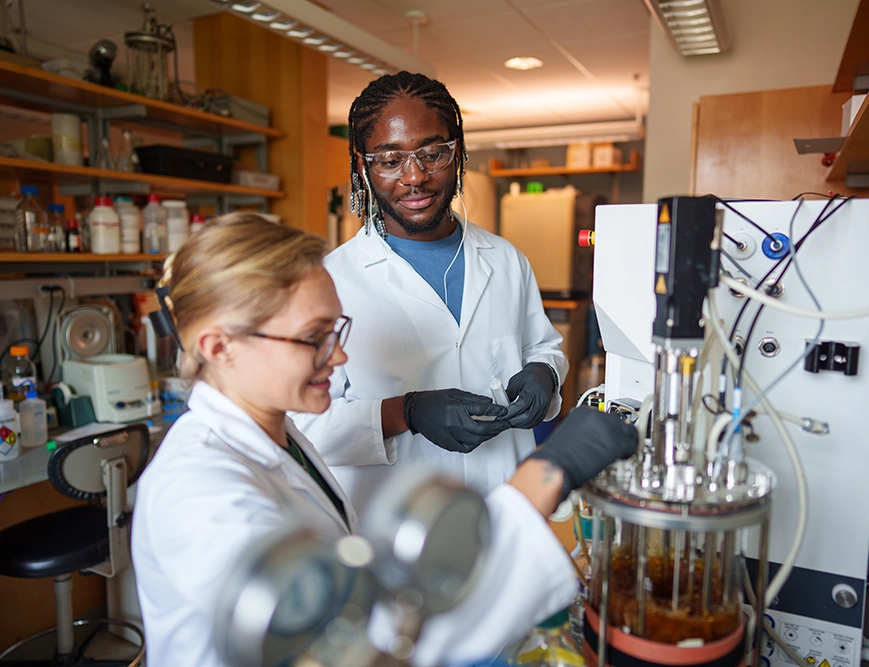
The Center of Integrated Biomedical and Bioengineering Research received a second $10 million award from the National Institutes of Health, enabling the center to continue advancing interdisciplinary research and innovation in the biomedical and bioengineering sciences.
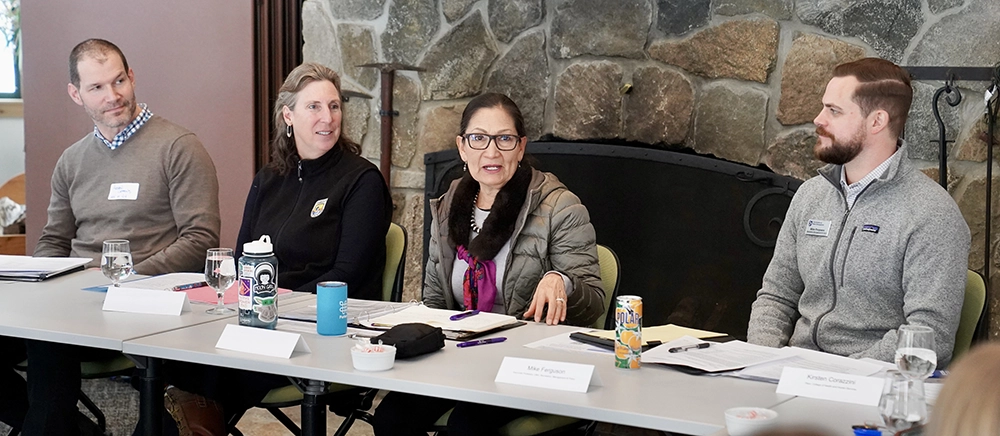
U.S. Secretaries of Agriculture and the Interior — Tom Vilsack and Deb Haaland (3rd from left), respectively — visited UNH this fall to meet with faculty, students, staff and the community.

Sara Morris is the new executive director of Shoals Marine Laboratory, a remote field station on Appledore Island operated jointly by UNH and Cornell University.
UNH acquired two new mass spectrometers — scientific instruments that measure the weight of molecules — for its University Instrumentation Center core facility.
A $2.6 million grant from the Health Resources & Services Administration of the U.S. Department of Health and Human Services provides tuition assistance to scores of psychiatric mental health nurse practitioner students to work in rural and underserved communities.


The heads of three major national partners — NASA, NOAA and the National Science Foundation (NSF) — visited UNH this year. NOAA Administrator Rick Spinrad (left) announced the creation of a new Center of Excellence for Operational Ocean and Great Lakes Mapping at UNH. NASA Administrator Bill Nelson joined U.S. Sen. Jeanne Shaheen for a campus visit highlighting UNH’s heliophysics expertise; Shaheen also joined NSF Director Sethuraman Panchanathan (top) for a tour of research facilities, including the John Olson Advanced Manufacturing Center and the InterOperability Lab.

The heads of three major national partners — NASA, NOAA and the National Science Foundation (NSF) — visited UNH this year. NOAA Administrator Rick Spinrad (top) announced the creation of a new Center of Excellence for Operational Ocean and Great Lakes Mapping at UNH. NASA Administrator Bill Nelson joined U.S. Sen. Jeanne Shaheen for a campus visit highlighting UNH’s heliophysics expertise; Shaheen also joined NSF Director Sethuraman Panchanathan (bottom) for a tour of research facilities, including the John Olson Advanced Manufacturing Center and the InterOperability Lab.

Ashby Kinch is the new vice provost and dean of the UNH Graduate School, effective July 8, 2024.

Faculty Honors





-
Nate Oldenhuis (1)
Assistant professor of chemistry
National Science Foundation Faculty Early Career Development Program (CAREER) award -
Nathan Laxague (2)
Assistant professor of mechanical and ocean engineering
National Science Foundation Faculty Early Career Development Program (CAREER) award -
Russell Congalton (3)
Professor of remote sensing and GIS
NASA/U.S. Geological Survey William T. Pecora Award -
Patricia Halpin
Professor of biological sciences and biotechnology, UNH Manchester
American Physiological Society Fellow -
Michelle Fournet
Assistant professor of biological sciences, affiliate faculty member of Center for Acoustics Research and Education
National Academy of Sciences Kavli Frontiers of Science Fellow -
Lynn Kistler
Professor of physics, director of the Space Science Center
American Geophysical Union Van Allen Lecture Award -
Joanne Malloy (4)
Research associate professor, Institute on Disability
N.H. Association of Social Workers Social Worker of the Year -
Will Smiley (9)
Associate professor of humanities
American Society for Legal History Surrency Prize and Burbank Prize -
Jennifer Miksis-Olds
Research professor, director of Center for Acoustics Research and Education
Chair, National Academies Ocean Acoustics Education and Expertise Committee -
April Bailey
Assistant professor of psychology
Association for Psychological Science Rising Star Award





-
Serita Frey (5)
Professor, natural resources and the environment
Clarivate Highly Cited Researcher -
Stuart Grandy (10)
Professor, natural resources and the environment
Clarivate Highly Cited Researcher -
Rachel Campagna (11)
Associate professor of management
Academy of Management Conflict Management Division Most Influential Article Award -
Goksel Yalcinkaya (12)
Professor of marketing
International Marketing Review Outstanding Paper Award -
Jennifer Griffith (13)
Associate professor of organizational behavior and management
Association to Advance Collegiate Schools of Business Influential Leader -
Marcy Doyle (6)
Research assistant professor, nursing
President, New Hampshire Nurses’ Association -
Jessica Lepler (7)
Associate professor of history
Harvard Fellowship -
Megan Carpenter
Dean, UNH Franklin Pierce School of Law
National Jurist 20 Most Influential People in Legal Education -
William McDowell (8)
Professor emeritus of natural resources and the environment
Fellow, Society for Freshwater Science -
Larry Mayer
Professor and director, Center for Coastal and Ocean Mapping
Scripps Institution of Oceanography Commencement Distinguished Alumni Keynote Speaker



Honors



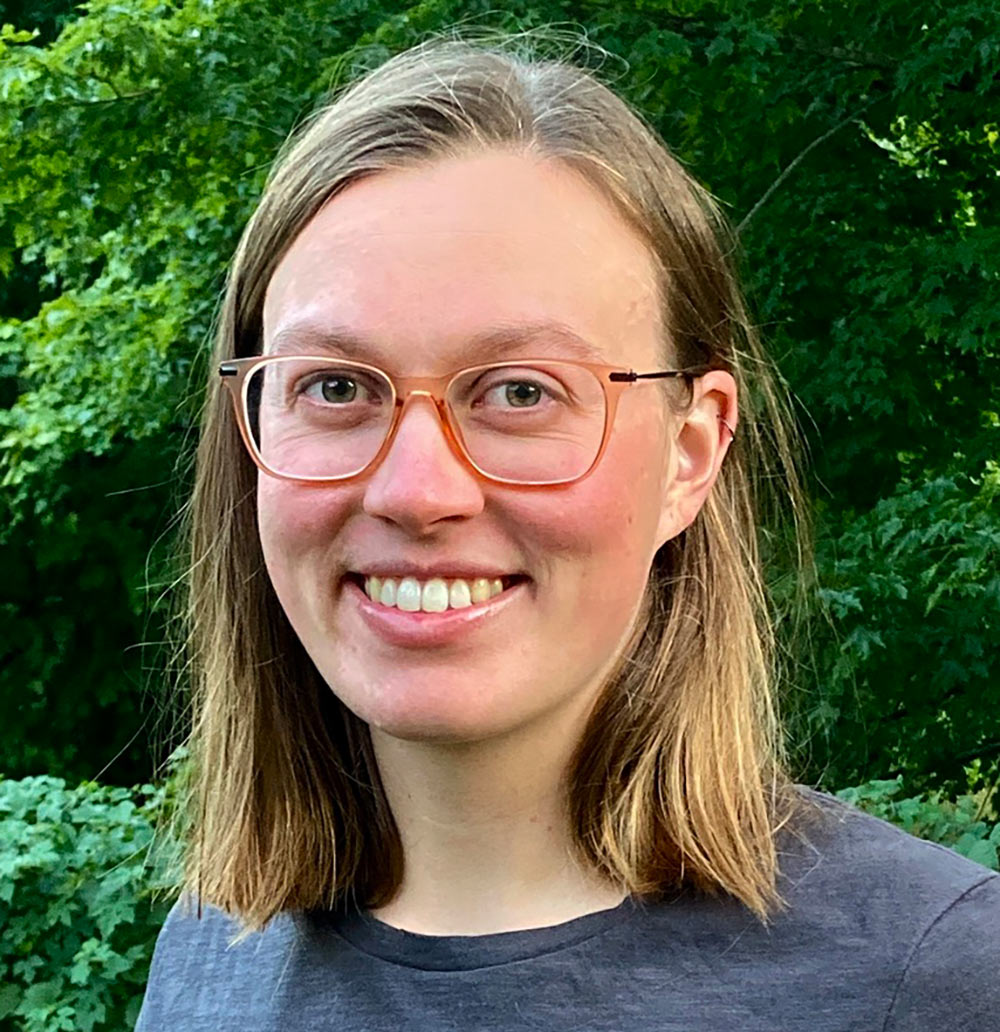
-
Jerome Amedu (1)
Postdoctoral researcher, mathematics and statistics
National Science Foundation Community for Advancing Discovery Research in Education (CADRE) Fellow -
Hyun Ju Kim (2)
Postdoctoral scholar, Institute on Disability
University of Wisconsin Junior Scholar Intensive Training (JSIT) Research Award -
Luke Botticelli ’23
Ph.D. student, biochemistry
National Science Foundation Graduate Research Fellowship -
Callyan Lacio (3)
Master’s student, integrative biology
National Science Foundation Graduate Research Fellowship -
Else Schlerman (4)
Ph.D. student, natural resources and Earth systems science
National Science Foundation Graduate Research Fellowship -
Nora Conrad ’23
Master’s student, national security intelligence analysis
Presidential Management Fellowship -
Sean Schaefer (5)
Ph.D. student, natural resources and Earth systems science
Department of Energy Graduate Student Research Program -
Karla Oñate Melecio (6)
Ph.D. candidate, physics
NASA Future Investigators in NASA Earth and Space Science and Technology (FINESST) Fellow -
Natalie Lord (7)
Ph.D. student, natural resources and Earth systems science
NOAA Sea Grant John A. Knauss Marine Policy Fellow -
James Irving
Ph.D. student, history
Truman Library Institute Dissertation Year Fellowship -
Sophie Wulfing ’23G
M.S., marine biology
Fulbright Grant



Findings
Dogging a Mysterious Illness
UNH researchers find major clue to canine respiratory syndrome
hen a mysterious illness sickened thousands of dogs across the country and confounded veterinarians this past winter, researchers at UNH’s New Hampshire Veterinary Diagnostic Laboratory (NHVDL) and Hubbard Center for Genome Studies played a critical role in solving it.
The UNH researchers identified a small portion of the genome of a previously uncharacterized bacteria that may be causing the illness, using genetic sequencing of samples from 70 dogs in New Hampshire, Rhode Island and Massachusetts from the last two years.
The researchers believe the bacterium may be host-adapted and potentially part of the dog microbiome and has recently developed the capacity to cause disease. Symptoms of infection in dogs include a cough that can linger for several weeks, runny eyes and sneezing. A very small subset of dogs have died after a long bout of this illness that is then complicated or superimposed with a severe acute pneumonia.

“A finding like this is potentially pretty exciting, even though we still have to see how it develops to a place where we are comfortable saying this is a pathogen in the syndrome,” says David Needle, pathology section chief at the NHVDL and a clinical associate professor. “You work at a state university to do work that you believe in, that is impactful and that you think has value, is engaging and interesting – and this really ticks all those boxes.”

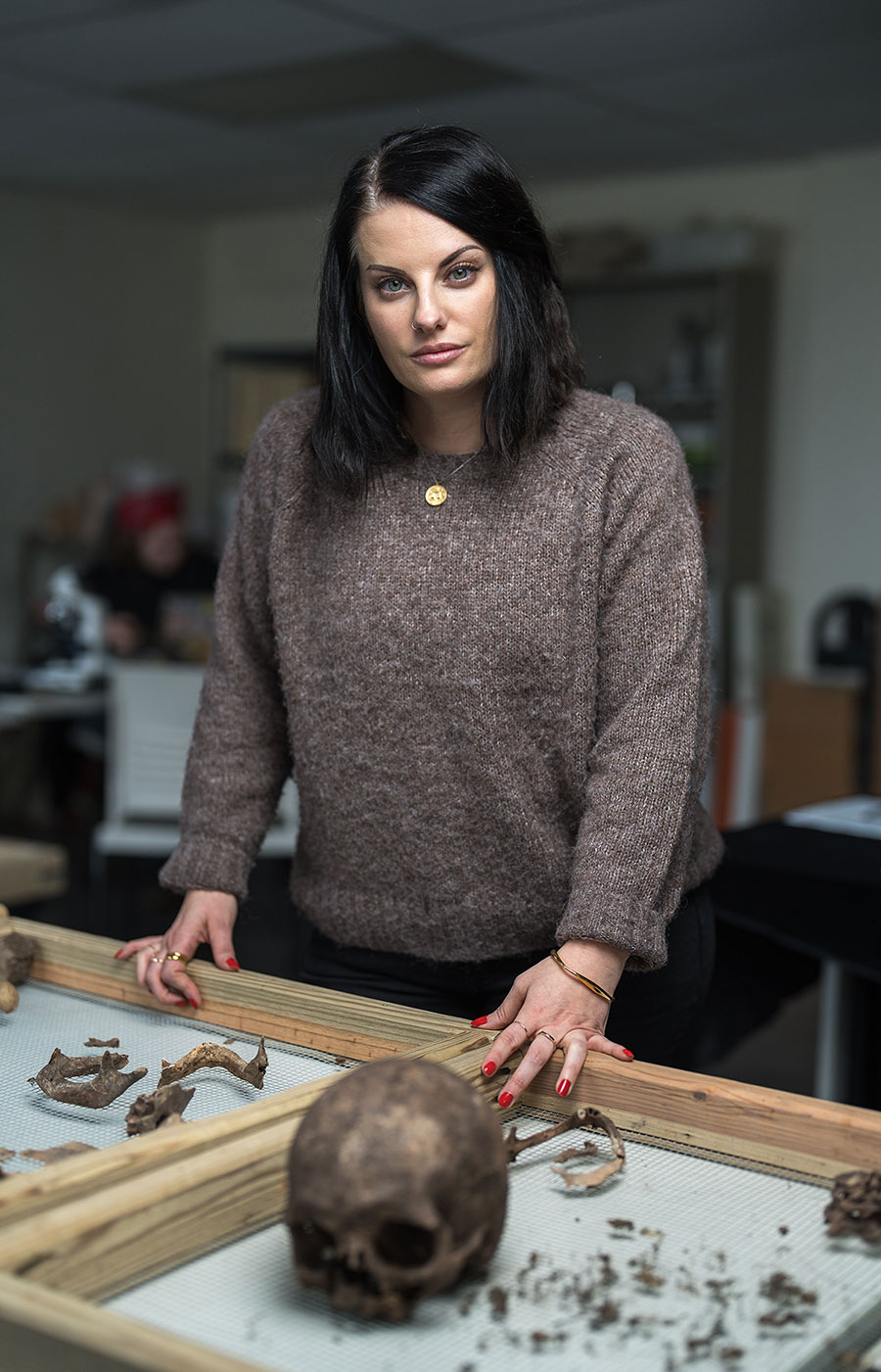
Discovering Ina Jane Doe
my Michael, assistant professor ofanthropology and director of UNH’sForensic Anthropology Identification and Recovery Lab, and true crime podcaster Laurah Norton (“The Fall Line”) have been joining forces to work on cold cases since 2018. Their latest collaboration is Norton’s first book, “Lay Them to Rest: On the Road with the Cold Case Investigators Who Identify the Nameless” (Hachette).
In it, Norton dives deep into forensic science, centering her narrative on solving the identity of Ina Jane Doe, a woman whose head was found in a rural Illinois park in 1993, with Michael and UNH students Kyana Burgess ’22 and Audrey Waterman ’21. The team’s investigation updated the original forensic sketch in collaboration with a forensic artist and used updated forensic methods that ultimately identified Susan Lund, a 25-year-old mother of three from Tennessee. Circumstances of her murder remain unsolved.
Michael talks about her collaboration on “Lay Them to Rest,” Ina Jane Doe/Susan Lund and assisting law enforcement identify John and Jane Does in New Hampshire and the nation.
Research Snapshot
Genetics and Sustainability
Apprentice with UNH cucurbit breeding and genetics, North America’s longest continuous squash and pumpkin breeding program
Mentored by assistant professor Chris Hernandez
Remote Research


lying a drone named Dottie hundreds of feet above a snowy forest in northern New Hampshire, Frankie Sullivan ’11G spots a female moose and her calf. Zooming in, he can see the moose’s ear tag, the type of vegetation she’s munching on and even some snowshoe hares hopping nearby — information that leads to better protection of some iconic mammal species.
Searching through data collected on Lake Huron, Val Schmidt sees what turns out to be the schooner Ironton, which sunk in thick fog in 1894. The remarkable images came from data collected by a survey team that included a snowmobile-sized uncrewed boat named BEN, which carries a high-resolution multibeam sonar system that can render an image of a shipwreck “as though it just sailed down to the bottom of the lake,” Schmidt says.
Across UNH, researchers are harnessing remote technology such as drones and autonomous surface vessels (ASVs) — robot eyes in the sky and on the water — to get a bigger, better and often faster and safer look at the world around us.

Advancing Sustainable Business

huili Du remembers when business profit and social impact were widely perceived as mutually exclusive.
Du, a professor of marketing at UNH’s Peter T. Paul College of Business and Economics, has spent her career changing that perception by focusing her research on how corporate social responsibility (CSR) and sustainability can simultaneously benefit society and businesses.
“Academic research has played a huge role in changing business managers’ perceptions,” Du says. “In business, there is kind of this conflict between the short-term and the long-term. In academic research, we are free to examine long-term impacts. We can show the data on how social initiatives impact a firm’s stock price or valuation. We have the empirical data that business and social interests are not contradictory; they help each other in the long term.”
Engaging Industry, Exceeding Expectations
By Beth Potier
s UNH deepens its engagement with industry and seeks to meet the state and region’s workforce needs, there’s perhaps no richer partnership than that with New Hampshire-based GreenSource Fabrication, a leader in “green” printed circuit board manufacturing.
Facilities collaboration and co-location? Check. GreenSource has installed its InduBond X-Press at UNH’s John Olson Advanced Manufacturing Center.
Workforce development and career opportunities? Check. UNH students gain hands-on experience with this cutting-edge technology through GreenSource Fabrication (GSF) internships at the Olson Center.
Alumni engagement? So many checks. Half of GreenSource’s engineers are Wildcats, including Maria Virga ’21, who oversees the Olson Center internships.
Ecological Eavesdropping

he watershed moment of Laura Kloepper’s scientific career arrived while she was standing near a massive cave in the desert Southwest. Kloepper had spent years studying the acoustics — the science of sound — of both dolphins and bats, two species that use echolocation in similar ways. But as she watched the entire bat colony burst forth into the evening sky, she was dumbfounded.
“Seeing millions of bats fly out of the cave using echolocation and yet being so close to one another – that changed everything for me,” says Kloepper, a UNH assistant professor of biological sciences. “I realized that all the traditional acoustic strategies I had previously learned to count animals and understand their behaviors really break down when there are dense aggregations of them.”
Fascinated by this new direction in her research, she went on to apply the concept of an acoustic energy index, which focuses on the overall vocal energy (think: audio volume) of large animal groups to estimate their populations more accurately. This tool has also been proven to be immensely useful for the wide-ranging research that her graduate students conduct: examining the soundscapes of tern colonies, penguins in Antarctica, seals hauling out on Cape Cod, and frogs in ponds surrounding UNH’s Durham campus.

UNH Extension
Extension to the Rescue
or farmers in New Hampshire and throughout the northeast, the 2023 production season was extremely challenging. Widespread freezing temperatures in February and May caused the greatest fruit crop loss in many years. February’s sub-zero temperatures, which reached -21F in the coldest parts of New Hampshire, took out stone fruits like peaches, sweet cherries and plums. Then came a major freeze in mid-May, during the peak of apple bloom in the state, resulting in the loss of more than 1,000 acres of fruit crops.
UNH Extension, in consultation with partner organizations including the N.H. Department of Agriculture and USDA Farm Service Agency, recognized the need for action. Within a matter of weeks, Extension specialists distributed a crop loss survey capturing estimated damage levels on 70 farms representing more than 1,000 acres. In the survey, growers estimated the economic impact of lost crop value of these two events at over $10 million.
The damage from the freeze events was acute and obvious, but the story does not end there. Two additional surveys captured vegetable, field and forage crop losses due to excess rainfall and flooding totaling another $5.5 million.
Extension’s work contributed to the approval of $8 million for crop loss relief funding for New Hampshire farmers. Extension met with each U.S. senator and congressional representative or staffer directly, as well as with Governor Chris Sununu, to educate them about the impacts and need for relief funding. U.S. Sen. Jeanne Shaheen brought information Extension provided her directly to the Senate floor while advocating for federal disaster relief for New Hampshire farmers.
UNH Extension continues to educate legislators and agricultural service providers on the impacts of severe weather events on New Hampshire agriculture in 2023 and provides programming to help producers be as prepared as possible in the future.

UNH Extension
Extension to the Rescue
or farmers in New Hampshire and throughout the northeast, the 2023 production season was extremely challenging. Widespread freezing temperatures in February and May caused the greatest fruit crop loss in many years. February’s sub-zero temperatures, which reached -21F in the coldest parts of New Hampshire, took out stone fruits like peaches, sweet cherries and plums. Then came a major freeze in mid-May, during the peak of apple bloom in the state, resulting in the loss of more than 1,000 acres of fruit crops.
UNH Extension, in consultation with partner organizations including the N.H. Department of Agriculture and USDA Farm Service Agency, recognized the need for action. Within a matter of weeks, Extension specialists distributed a crop loss survey capturing estimated damage levels on 70 farms representing more than 1,000 acres. In the survey, growers estimated the economic impact of lost crop value of these two events at over $10 million.
The damage from the freeze events was acute and obvious, but the story does not end there. Two additional surveys captured vegetable, field and forage crop losses due to excess rainfall and flooding totaling another $5.5 million.
Extension’s work contributed to the approval of $8 million for crop loss relief funding for New Hampshire farmers. Extension met with each U.S. senator and congressional representative or staffer directly, as well as with Governor Chris Sununu, to educate them about the impacts and need for relief funding. U.S. Sen. Jeanne Shaheen brought information Extension provided her directly to the Senate floor while advocating for federal disaster relief for New Hampshire farmers.
UNH Extension continues to educate legislators and agricultural service providers on the impacts of severe weather events on New Hampshire agriculture in 2023 and provides programming to help producers be as prepared as possible in the future.
Made in Space


hen a spacecraft lands on or blasts off from the moon, it kicks up a considerable cloud of dust and debris that, given the lack of gravity, can take years to fully settle. But what if it were possible to manufacture a landing pad on the moon’s surface using a combination of materials already available in space, making a lunar settlement a legitimate possibility?
It may sound like a far-fetched futuristic plot, but there’s a world in which it’s a reality within the next decade — and it’s a world UNH is helping bring into sharper focus.
“When you talk about a mission to Mars or even a lunar settlement, you’re not going to be able to rely on parts being supplied from Earth. If something breaks, you are going to need to be able to manufacture it there, on site,” says Brad Kinsey, associate dean of UNH’s College of Engineering and Physical Sciences. “Companies are already thinking about ways to use materials in space to build a landing pad on the lunar surface. There is talk about a lunar base within 10 years, and the goal is for UNH to be a part of that.”
His moment in the Sun


Cohen, who received his Ph.D. in space physics from UNH, is the deputy chief scientist of the Space Exploration Sector at the Johns Hopkins Applied Physics Laboratory (APL), where he’s worked since he left UNH.
And as our nation turns its gaze to the sun (safely, we hope) to witness a total eclipse, watch the Parker Solar Probe spacecraft get closer than ever to the sun or celebrate NASA’s Heliophysics Big Year, Cohen is seemingly everywhere: presenting at scientific meetings, quoted in the Wall Street Journal, meeting with policymakers, even showing up in social media videos to explain concepts like space weather.
By the Numbers

Research Funding
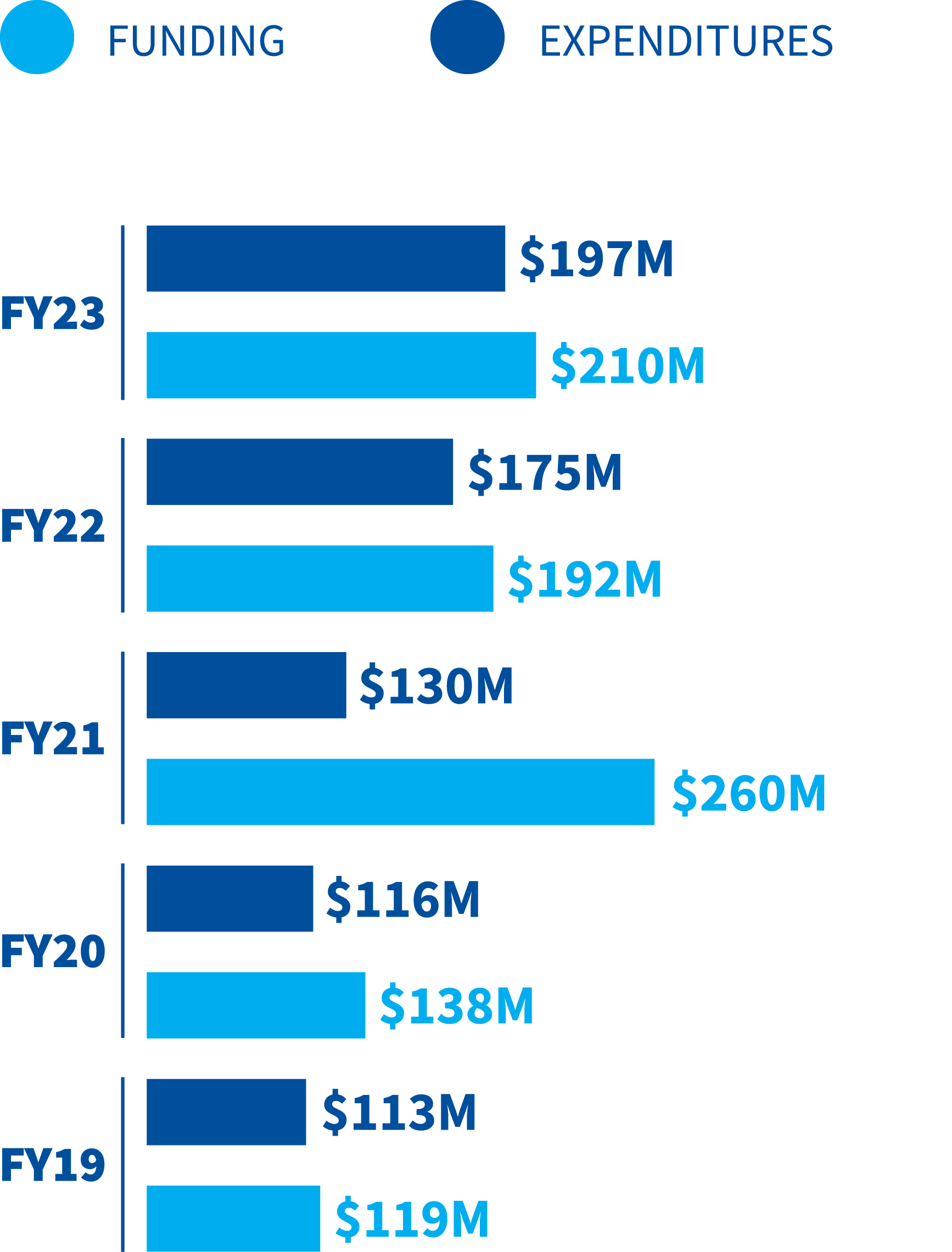
Federal Government Funding Sources


Total Research Funding Sources
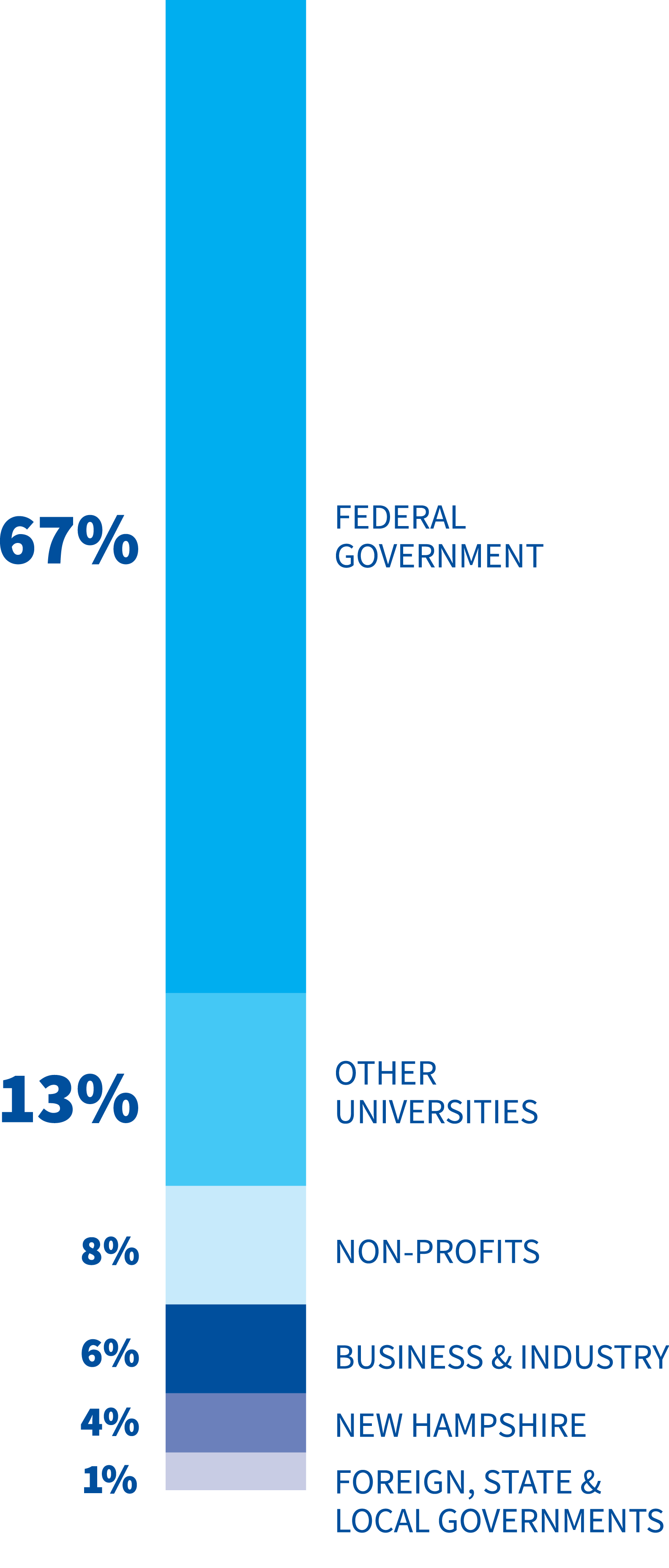
Innovation

Extension

stook ▸ n. 1. a group of sheaves of grain stood on end in a field to dry
Museum studies student Sydney Rue ’24G arranges a stook of flax grown at UNH for the Flax to Linen Project. The experiential learning initiative aimed to untangle the history and prominence of linen in New England by planting flax, harvesting it, processing it into linen thread, weaving it into fabric and creating a garment. Led by senior lecturer of history Kimberly Alexander, the project culminated in an exhibit at the Woodman Museum in Dover, New Hampshire.

